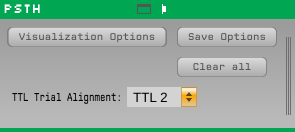This plugin has been deprecated.
Function
Aligns spikes and LFP to specific events, either sent through the Network Events source, or through hardware TTLs.
...
- Event type (uint8) which can have one of the following types:
- SESSION (code 10)
- This will inform that a new recording session has started /stopped
- TTL (code 3)
- This will inform that a digital signal went up/down
- NETWORK (code 7)
- This will inform of a string message arrived via Ethernet
- SPIKE (code 4)
- This will inform of a detected spike
- TIMESTAMP (code 0)
- This will save a pair of software & hardware timestamps, to allow synchornization between software events and hardware events.
- EYE_POSITION (code 8)
- This will inform that a new eye position signal has arrived.
- SESSION (code 10)
- Event size (uint16)
- Event specific data (variable length)
- SESSION
- uint8, representing whether a session has started (value = 1) or stopped (value = 0)
- uint16, representing recording session number
- int64, representing a software timestamp
- TTL
- uint8, representing whether the signal went up (value = 1), or down (value = 0)
- uint16, representing the channel number that was raised/lowered.
- int64, software timestamp
- int64, hardware timestamp
- NETWORK
- <variable length>, representing the incoming message. length of the message is the event size - 8
- int64, software timestamp
- SPIKE
- int64, software timestamp
- int64, hardware timestamp
- int16, sorted unit ID number
- int16, electrode ID number
- int16, number of channels in electrode (typically, 1, 2, or 4)
- float x number of channels: channel gain
- int16, number of points in each channel (typically 32+8).
- <variable length>, representing the spike wave form. actual size will depend on the previous two numbers.
- TIMESTAMP
- int64, software timestamp
- int64, hardware timestamp
- EYE_POSITION
- double, x position
- double, y position
- double, pupil diameter
- int64, software timestamp
- int64, hardware timestamp
- SESSION
Known bugs
...
